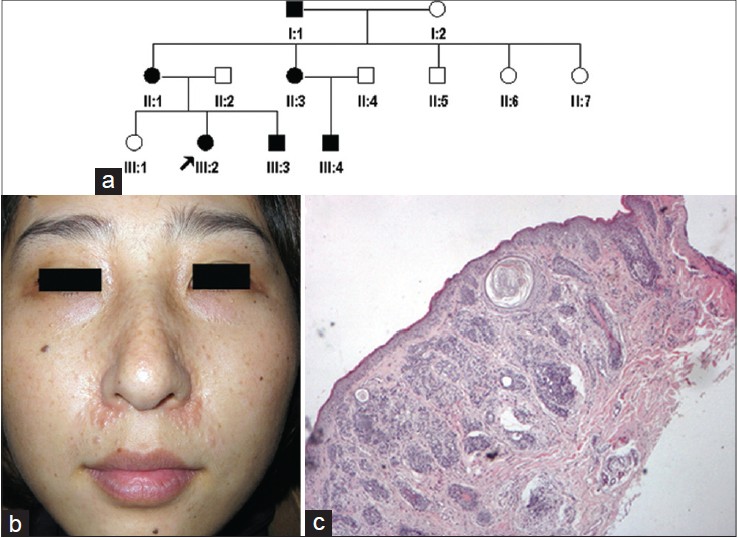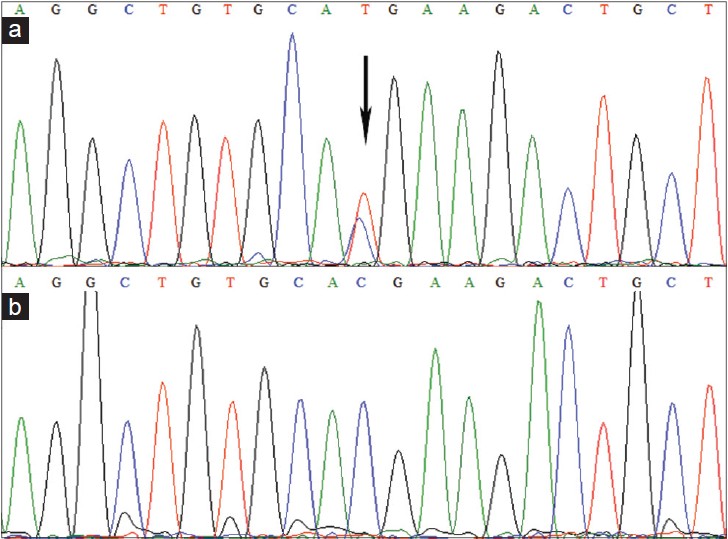Translate this page into:
A recurrent R936X mutation of CYLD gene in a Chinese family with multiple familial trichoepithelioma
Correspondence Address:
Yan-Hua Liang
Department of Dermatology, Nanfang Hospital, Southern Medical University, Guangzhou, Guangdong 510515
China
| How to cite this article: Zhang QG, Liang YH. A recurrent R936X mutation of CYLD gene in a Chinese family with multiple familial trichoepithelioma. Indian J Dermatol Venereol Leprol 2015;81:192-194 |
Sir,
Multiple familial trichoepithelioma (MFT; OMIM 601606) is an autosomal dominant skin disease characterized by the presence of many small benign tumors with pilar differentiation predominantly on the face. Mutations of the cylindromatosis (CYLD) gene have been first identified as the cause of multiple familial trichoepithelioma from Chinese Han populations in 2004. Loss of the deubiquitinating activity of CYLD protein is correlated with tumorigenesis. [1] Herein, we report a Chinese family with multiple familial trichoepithelioma with a recurrent mutation of CYLD, designated c. 2806C>T.
In this study, a large Chinese family consisting of six multiple familial trichoepithelioma patients in three generations was investigated [Figure - 1]a. The proband in the family was a 25-year-old female. She initially developed trichoepitheliomas at the age of 11 years. Dermatological examination showed numerous, dome-shaped, firm skin-colored papules and nodules involving the surface of nose, and the nasolabial folds [Figure - 1]b. Lesional skin biopsy from the proband revealed the typical histopathological characteristics of trichoepithelioma, such as palisade-like arrangement of small basaloid cells and multiple horn cysts with a fully keratinized center [Figure - 1]c. Blood samples were obtained from available family members and 100 unrelated controls.
 |
| Figure 1: The circles indicate females, the squares males. Blackened symbols represent affected individuals, open symbols represent unaffected individuals. The proband in the family (Individual III:2) is indicated by an arrow (a). Numerous trichoepitheliomas in the nasal region and nasolabial folds (b); Histology of trichoepithelioma excised from the face of the proband (H and E, 100×). Well-demarcated nodules consist of small basaloid cells that are arranged in a palisade-like pattern; multiple horn cysts with a fully keratinized center surrounded by basaloid cells lie free in the fibrous stroma. (c) |
After informed consent and approval of human medical and ethics committee of Southern Medical University, genomic DNA was extracted from peripheral blood with a DNA isolation kit (Simgen Inc., Hangzhou, China). Polymerase chain reactions were performed as described in a previous study. [2] All polymerase chain reaction products were directly sequenced using dye terminator chemistry on an ABI 3730xl DNA Analyzer (Applied Biosystems, Foster City, CA). In addition, samples from 100 unrelated controls were sequenced to exclude the CYLD polymorphisms possibilities.
Sequence analysis identified a recurrent nonsense mutation, a change of C to T at nucleotide position 2806 in exon 20 in CYLD gene, resulting in a substitution of arginine (CGA) to terminal code (TGA) at position 936(p.R936X) in the proband [Figure - 2]a. The same mutation was not found in 100 unrelated individuals [Figure - 2]b.
 |
| Figure 2: (a) Heterozygous c.2806(C>T) (p.R936X) mutation in exon 20 of the CYLD gene in proband of the pedigree. (b) Sequence of exon 20 of the CYLD gene in normal controls |
The mutation c. 2806C>T (p.R936X) in CYLD has been reported in several studies. Bowen et al. identified a heterozygous R936X mutation in a Canadian woman with Brooke-Spiegler syndrome (BSS) who had cylindromas and trichoepitheliomas. [3] In a 73-year-old male with cylindromatosis and turban tumor syndrome, the heterozygous 2806C>T transition in the CYLD gene was identified. His two children, also carrying the mutation, had multiple familial trichoepithelioma without cylindromas. The findings suggested phenotypic variation of a single genetic defect. [4] The same nonsense mutation was identified in a woman of Czech ethnic background, who was one case from a series of 24 cases who developed malignant neoplasms arising in preexisting benign spiradenoma (n = 20), cylindroma (n = 2), or spiradenocylindroma (n = 2). [5] The development of malignant transformation in benign neoplasms in patients with p.R936X mutation of CYLD gene may be due to a second mutation in the tumor tissue or a homozygous c. 2806C>T mutation. Unfortunately, none of the previous studies were able to provide evidence of such mutation in patients who developed the malignant neoplasms.
In this study, we reported a large Chinese family with multiple familial trichoepithelioma and identified a recurrent nonsense mutation c. 2806C>T, leading to p.R936X in exon 20 of CYLD gene. This study expands the clinical heterogeneity of multiple familial trichoepitheliomas due to the same mutation (c. 2806C>T) in CYLD and contributes to enrichment of the database of the CYLD mutations underlying multiple familial trichoepitheliomas in the Chinese population. In the light of previous studies, our findings also suggest that though the mutation c. 2806C>T in CYLD mainly leads to a ′benign′ phenotype such as multiple familial trichoepithelioma Brooke-Spiegler syndrome, but may also result in a malignant phenotype.
| 1. |
Liang YH, Gao M, Sun LD, Liu LJ, Cui Y, Yang S, et al. Two novel CYLD gene mutations in Chinese families with trichoepithelioma and a literature review of 16 families with trichoepithelioma reported in China. Br J Dermatol 2005;153:1213-5.
[Google Scholar]
|
| 2. |
Zhang XJ, Liang YH, He PP, Yang S, Wang HY, Chen JJ, et al. Identification of the cylindromatosis tumor-suppressor gene responsible for multiple familial trichoepithelioma. J Invest Dermatol 2004;122:658-64.
[Google Scholar]
|
| 3. |
Bowen S, Gill M, Lee DA, Fisher G, Geronemus RG, Vazquez ME, et al. Mutations in the CYLD gene in Brooke-Spiegler syndrome, familial cylindromatosis, and multiple familial trichoepithelioma: Lack of genotype-phenotype correlation. J Invest Dermatol 2005;124:919-20.
[Google Scholar]
|
| 4. |
Young AL, Kellermayer R, Szigeti R, Tészás A, Azmi S, Celebi JT. CYLD mutations underlie Brooke-Spiegler, familial cylindromatosis, and multiple familial trichoepithelioma syndromes. Clin Genet 2006;70:246-9.
[Google Scholar]
|
| 5. |
Kazakov DV, Zelger B, Rütten A, Vazmitel M, Spagnolo DV, Kacerovska D, et al. Morphologic diversity of malignant neoplasms arising in preexisting spiradenoma, cylindroma, and spiradenocylindroma based on the study of 24 cases, sporadic or occurring in the setting of Brooke-Spiegler syndrome. Am J Surg Pathol 2009;33:705-19.
[Google Scholar]
|
Fulltext Views
1,919
PDF downloads
1,154





